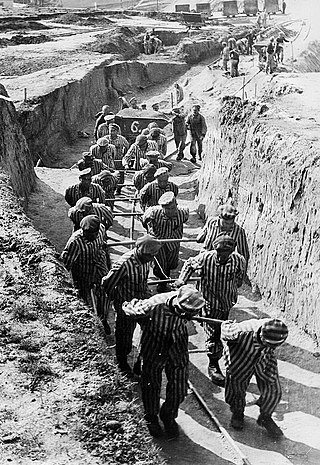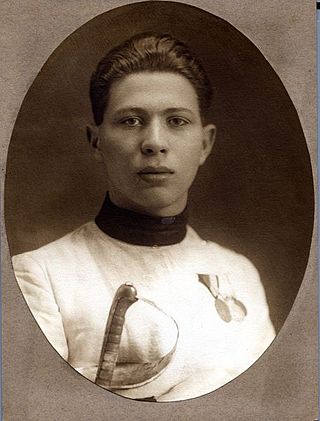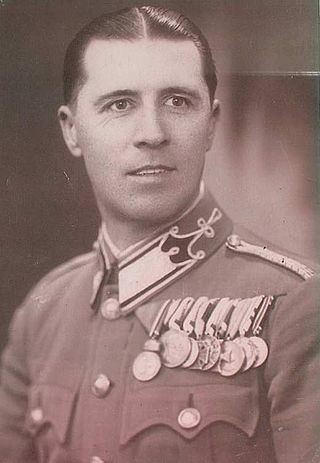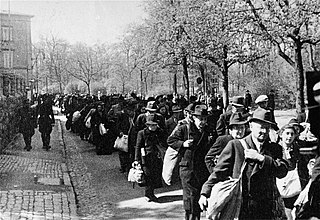| Part of a series on the |
| History of Jews and Judaism in Belarus |
|---|
| |
| Historical Timeline • List of Jews |
| |
Davidovka concentration camp was a Hungarian-controlled World War II labor camp in Davidovka. [1] [2]
| Part of a series on the |
| History of Jews and Judaism in Belarus |
|---|
| |
| Historical Timeline • List of Jews |
| |
Davidovka concentration camp was a Hungarian-controlled World War II labor camp in Davidovka. [1] [2]

Auschwitz concentration camp was a complex of over 40 concentration and extermination camps operated by Nazi Germany in occupied Poland during World War II and the Holocaust. It consisted of Auschwitz I, the main camp (Stammlager) in Oświęcim; Auschwitz II-Birkenau, a concentration and extermination camp with gas chambers; Auschwitz III-Monowitz, a labour camp for the chemical conglomerate IG Farben; and dozens of subcamps. The camps became a major site of the Nazis' Final Solution to the Jewish question.

The Schutzstaffel was a major paramilitary organisation under Adolf Hitler and the Nazi Party in Nazi Germany, and later throughout German-occupied Europe during World War II.

From 1933 to 1945, Nazi Germany operated more than a thousand concentration camps, including subcamps on its own territory and in parts of German-occupied Europe.

The Warsaw concentration camp was a German concentration camp in occupied Poland during World War II. It was formed on the base of the now-nonexistent Gęsiówka prison, in what is today the Warsaw neighbourhood of Muranów, on the order of Reichsführer-SS Heinrich Himmler. The camp operated from July 1943 to August 1944.

Kaiserwald (Ķeizarmežs) was a Nazi concentration camp near the Riga suburb of Mežaparks in modern-day Latvia.

Theodor Dannecker was a German SS-captain, a key aide to Adolf Eichmann in the deportation of Jews during World War II.
The history of the Jews during World War II is almost synonymous with the persecution and murder of Jews which was committed on an unprecedented scale in Europe and European North Africa. The massive scale of the Holocaust which happened during World War II greatly affected the Jewish people and world public opinion, which only understood the dimensions of the Final Solution after the war. The genocide, known as HaShoah in Hebrew, aimed at the elimination of the Jewish people on the European continent. It was a broadly organized operation led by Nazi Germany, in which approximately six million Jews were murdered methodically and with horrifying cruelty. Although the Holocaust was organized by the highest levels of the Nazi German government, the vast majority of Jews murdered were not German, but were instead residents of countries invaded by the Nazis after 1938. Of the approximately 6 million Jews murdered by the Nazis, approximately 160,000 to 180,000 were German Jews. During the Holocaust in occupied Poland, more than one million Jews were murdered in gas chambers of the Auschwitz concentration camp alone. The murder of the Jews of Europe affected Jewish communities in Albania, Austria, Belarus, Belgium, Bosnia & Herzegovina, Channel Islands, Croatia, Czech Republic, Estonia, France, Germany, Greece, Hungary, Italy, Latvia, Libya, Lithuania, Luxembourg, Moldova, the Netherlands, North Macedonia, Norway, Poland, Romania, Russia, Serbia, Slovakia, and Ukraine.

Attila Petschauer was a Hungarian Olympic champion sabre fencer of Jewish heritage.

The history of the Jews in Slovakia goes back to the 11th century, when the first Jews settled in the area.

The history of the Jews in the Czech lands, historically the Lands of the Bohemian Crown, including the modern Czech Republic, goes back many centuries. There is evidence that Jews have lived in Moravia and Bohemia since as early as the 10th century. Jewish communities flourished here specifically in the 16th and 17th centuries, and again in the late 19th and early 20th centuries. Local Jews were mostly murdered in the Holocaust, or exiled at various points. As of 2021, there were only about 2,300 Jews estimated to be living in the Czech Republic.

Holocaust trains were railway transports run by the Deutsche Reichsbahn national railway system under the control of Nazi Germany and its allies, for the purpose of forcible deportation of the Jews, as well as other victims of the Holocaust, to the Nazi concentration, forced labour, and extermination camps.
Responsibility for the Holocaust is the subject of an ongoing historical debate that has spanned several decades. The debate about the origins of the Holocaust is known as functionalism versus intentionalism. Intentionalists such as Lucy Dawidowicz argue that Adolf Hitler planned the extermination of the Jewish people as early as 1918, and personally oversaw its execution. However, functionalists such as Raul Hilberg argue that the extermination plans evolved in stages, as a result of initiatives that were taken by bureaucrats in response to other policy failures. To a large degree, the debate has been settled by acknowledgement of both centralized planning and decentralized attitudes and choices.

The Holocaust in the Independent State of Croatia involved the genocide of Jews, Serbs and Romani within the Independent State of Croatia, a fascist puppet state that existed during World War II, led by the Ustaše regime, which ruled an occupied area of Yugoslavia including most of the territory of modern-day Croatia, the whole of modern-day Bosnia and Herzegovina and the eastern part of Syrmia (Serbia). Of the 39,000 Jews who lived in the NDH in 1941, the United States Holocaust Memorial Museum states that more than 30,000 were murdered. Of these, 6,200 were shipped to Nazi Germany and the rest of them were murdered in the NDH, the vast majority in Ustaše-run concentration camps, such as Jasenovac. The Ustaše were the only quisling forces in Yugoslavia who operated their own extermination camps for the purpose of murdering Jews and members of other ethnic groups.

The Holocaust in German-occupied Serbia was part of the European-wide Holocaust, the Nazi genocide against Jews during World War II, which occurred in the Territory of the Military Commander in Serbia, the military administration of the Third Reich established after the April 1941 invasion of Yugoslavia. The crimes were primarily committed by the German occupation authorities who implemented Nazi racial policies, assisted by the collaborationist forces of the successive puppet governments established by the Germans in the occupied territory.

During World War II, the Kingdom of Hungary engaged in the military occupation, then annexation, of the Bačka, Baranja, Međimurje and Prekmurje regions of the Kingdom of Yugoslavia. These territories had all been under Hungarian rule prior to 1920, and had been transferred to Yugoslavia as part of the post-World War I Treaty of Trianon. They now form part of several states: Yugoslav Bačka is now part of Vojvodina, an autonomous province of Serbia, Yugoslav Baranja and Međimurje are part of modern-day Croatia, and Yugoslav Prekmurje is part of modern-day Slovenia. The occupation began on 11 April 1941 when 80,000 Hungarian troops crossed the Yugoslav border in support of the German-led Axis invasion of Yugoslavia that had commenced five days earlier. There was some resistance to the Hungarian forces from Serb Chetnik irregulars, but the defences of the Royal Yugoslav Army had collapsed by this time. The Hungarian forces were indirectly aided by the local Volksdeutsche, the German minority, which had formed a militia and disarmed around 90,000 Yugoslav troops. Despite only sporadic resistance, Hungarian troops killed many civilians during these initial operations, including some Volksdeutsche. The government of the newly formed Axis puppet state, the Independent State of Croatia, subsequently consented to the Hungarian annexation of the Međimurje area, which dismayed the Croat population of the region.

The Holocaust in Hungary was the dispossession, deportation, and systematic murder of more than half of the Hungarian Jews, primarily after the German occupation of Hungary in March 1944.

The Jägerstab was a Nazi German governmental task force whose aim was to increase production of fighter aircraft during World War II. Established in March 1944, it was composed of government and SS personnel, as well as representatives of the aircraft manufacturers. The task force played a key role in the Emergency Fighter Program, including the "people's fighter" Heinkel He 162.

The Holocaust in the Sudetenland resulted in the flight, dispossession, deportation and ultimately death of many of the 24,505 Jews living in the Reichsgau Sudetenland, an administrative region of Nazi Germany established from former Czechoslovak territory annexed after the October 1938 Munich Agreement. Due to harassment and violence, including during Kristallnacht, ninety percent of the Jews had already left the Sudetenland by mid-1939. The remaining Jews were subject to property confiscation and eventually deportation. During the later years of the war, tens of thousands of Jews and non-Jews were forced laborers in a network of concentration camps in the Sudetenland.

László Ferenczy was a lieutenant colonel in the Hungarian Royal Gendarmerie and member of its "central dejewification unit" during World War II and the Holocaust.

The question of how much Germans knew about the Holocaust while it was ongoing continues to be debated by historians. With regard to Nazi Germany, some historians argue that it was an open secret amongst the population, whilst others highlight a possibility that the German population were genuinely unaware of the Final Solution. Peter Longerich argues that the Holocaust was an open secret by early 1943, but some authors place it even earlier. However, after the war, many Germans claimed that they were ignorant of the crimes perpetrated by the Nazi regime, a claim associated with the stereotypical phrase "Davon haben wir nichts gewusst".